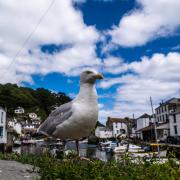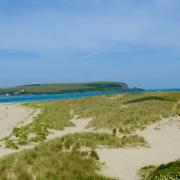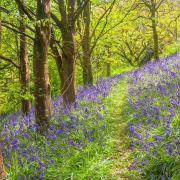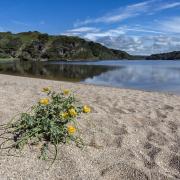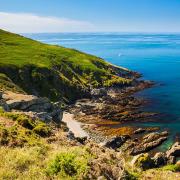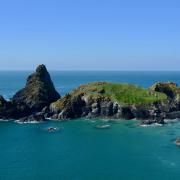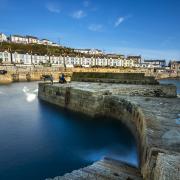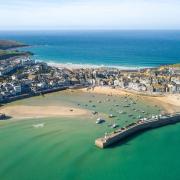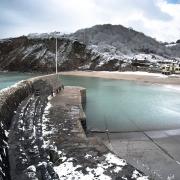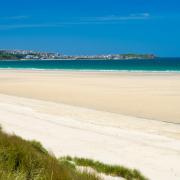Whether you’re an avid rambler looking for a long stretch of sand, on the hunt for somewhere to have a paddle, or a surfboard-ready water sports fanatic – Cornwall’s sandy beaches are some of the most stunning in the country with something for everyone.

Porthmeor Beach, St Ives
Anyone who has ever been into Tate St Ives, will probably find themselves turning their back on the priceless art on display - at least for a few minutes - to take in the view of Porthmeor Beach. Renowned for its top quality surf, Porthmeor is probably one of Cornwall's most photographed beaches simply by its position in the shadow of the newly extended gallery.
One of the trio of St Ives' beaches - the others being Porthminster and the more diminutive Porthgwidden - Porthmeor is a crescent of white sand surrounded by high headlands on either side. Sitting at its middle is the Porthmeor Beach Café where seats on its top terrace are in high demand during warm sunny days (and quite a few colder ones). There are chalets at one end available for rent by the week - if you don't fancy dragging your beach paraphernalia up to your car (the most available car park is a bit of a hike - or you can get the train in from nearby St Erth and enjoy the spectacular views en route).
For surfers it's known for its hollow, fast, north-facing break (that those in the know say works best in bigger swells). In the water there are surfers and swimmers of all ages and abilities and lifeguard cover from Easter to the end of October. Dogs are only allowed on the beach out of season.

Pendower Beach, Veryan
If you are looking for something crescent shaped with golden sand, gently lapping waves and somewhere the dogs or small children can paddle in with safety, than head to the Roseland.
This tiny peninsula is one of Cornwall's hottest spots - and property here is at a premium. A visit to the local beaches will reveal why. It's surprisingly easy to access - either by road from Truro or across from Falmouth on the ferry to St Mawes.
We head to Pendower Beach in Veryan. This south-facing sandy beach has stunning views along the coastline. Owned by the National Trust, the beach joins with Carne Beach at low tide.
The beach sits beneath low soft cliffs and rock pools which have been designated Sites of Special Scientific Interest so expect to enjoy an afternoon's rockpooling here. There's plenty to do in the water too - swimming, scuba diving, surfing, sea canoeing, sailing, windsurfing, fishing and snorkelling. Or you can simply sit back and watch the water activities from the comfort of your beach towel.
This beach is worth a visit at any time of year and there are great views even just from the car park. Dogs are welcome all year, but on leads in the summer months. Alongside its many charms, the beach has that most important of attractions: public toilets.

Pedn Vounder, Porthcurno
Porthcurno has seen more than the usual number of visitors to one of its loveliest beaches. Why? All thanks to that pesky Poldark. The fourth series used the beach in a dream sequence of 'Nampara Cove'.
Even before its starring TV role, it is often considered as the poster child of Cornwall's beaches - combining immaculately clear blue waters, soft white sand. It even comes with its own dramatic landmark - complete with its own myth: Logan Rock is a rectangular block of granite which weighs about 70 tonnes, and can be rocked back and forth by one person.
Pedn Vounder (meaning 'end of lane') is a classic Cornish understatement for a beach that resembles a dream Greek island.
Sitting at the tip of Penwith coast near Land's End, it is one of the county's most remote spots. At low spring low tide you can walk to Pedn Vounder from the neighbouring Porthcurno beach or access via the coast path and a steep cliff path that is more like coasteering than a gentle stroll, so pack light for your day out. If that sounds like too much effort, you can see the beach and its crescent-shaped beach from the clifftop Minack Theatre.
Family friendly? Alongside its difficult access, its sheltered location has made it an unofficial naturist beach in recent years. You've been warned.

Porthminster, St Ives
St Ives has long been a favourite with sunseekers and at Porthminster there is always something a bit special on offer. This white sandy beach rarely stays empty whatever the weather.
One of its many attractions is The Porthminster Beach Cafe - boasting an incredible menu, amazing views and a well-earned reputation for keeping it Cornwall. This award-winning restaurant specialises in Mediterranean and Asian seafood cuisine so come hungry and prepared to be impressed.
In the winter, on New Year's Day, you can join hundreds of brave souls and take part in an out of season dip at Porthminster. This tradition, repeated at nearby Hayle and Sennen Cove (among others) starts at 11am and lasts as long as your circulation. Dozens of people turn out to cheer the brave swimmers.
The St Ives Food & Drink Festival takes place on Porthminster Beach every May.

Rock Beach and Daymer Bay
Made famous by 1970s classic The Eagle has Landed- and the reason its star Jenny Agutter now calls Cornwall home - Rock and Daymer Bay is one of Cornwall's real gems and perfect for a beach walk during Cornwall's varied winter weather.
Rock is easily accessed from the foodie capital of Cornwall that is Padstow, via a short ferry ride - or it is worth the significantly longer drive around the Camel Estuary, this beach is the perfect spot for walking off all that glorious food.
If you couldn't get a table at Paul Ainsworth at No. 6 or the queue at Rick Stein was too long, Rock has plenty to satisfy the hungry with a number of eateries offering varied delicious menus and views to match.
The water gently laps the golden sand here, encouraging you to slip off your shoes and dip your toes in any weather; the fainter hearted can wade in their wellies. This spot is a favourite with dog walkers, and is a great walking beach - keep going and you will find yourself at the exquisite Daymer Bay, but who can tell when one ends and the other one begins. Officially part of the Camel Estuary, at times of the year and extreme low tide, it almost joins Padstow.
Rock is also home to an artistic community - here you'll find plenty of galleries to peruse, and artists working down lanes encouraging you to see their wares.

Sennen Cove
As every photographer knows the perfect beach sits between high cliffs with rolling waves splashing onto a white sandy beach in a smiling crescent. And for the added picturesque, an ancient lifeboat station sits on one end, while the famous Longships Lighthouse that straddles the water between Land's End and The Isles of Scilly sits in the distance.
One look at this gorgeous beach and you will be rolling up your trouser legs (or donning your wetsuit) and heading down the steps for a stroll (or swim) along the water's edge. Welcome to Sennen. The beach is sheltered from prevailing Atlantic winds by the cliffs of Pedn-men-du. The beach is our most westerly surf hotspot. With a long, sandy beach and small harbour the village combines working fishing port with laid back surf style.
The cliffs themselves are is a popular haunt for climbers and the village's lifeboat station established more than 150 years ago is open to visitors in summer.
The beach in one of the UK's most breathtaking locations - open to dogs out of season, there is RNLI cover from Easter to the October half term. Behind the beach is a car park (although this beach gets busy in the summer months, so arrive early or take the coast path route) while the village itself offers all the amenities you could want - cafés, restaurants, pubs, galleries and shops, with the Porthcurno Telegraph Museum nearby for a spot of culture.

Porthleven Sands Beach
Our new favourite beach sits hidden around the corner of the wonderful Porthleven Harbour - a highlight along the South West Coast Path.
Here you'll find three glorious miles of sand and steeply shelving shingle, stretching (when the tide is out) past Loe Bar and the Penrose Estate. Porthleven beach is next to the granite pier of the harbour and accessed from the village itself.
This is a grown up beach - there are strong undercurrents here that make it unsuitable for bathing, but there are lifeguards July - September if you fancy a paddle. There's a seasonal dog ban is in place here but dogs are welcome on this beach after 30 September.
If you are a watcher or a walker, beaches don't come much better than this. Find yourself a spot on the flight of steps (known as the Blue Buoy steps) with a coffee from the many great cafés in the harbour (we love the coffee and cakes from No. 12). Or walk off a hearty dinner from the varied eateries on offer in the foodie capital of Porthleven Harbour. Choose between Rick Stein Porthleven, Amélies and Kota - which serves up award-winning food from chef-owner Jude Kereama featured in Great British Menu. There's also a great ice cream parlour - our one request is to extend their open hours into the early evening to combine an outdoor pudding with a Cornish passeggiata.

Praa Sands
Although given a Penzance address, this long stretch of white sands and lazily lapping sea is a surprisingly quiet spot far from the madding crowd that flocks to one of Cornwall's favourite seaside towns. This is without doubt one of the best beaches in Cornwall. It's a south-west facing mile-long stretch of golden sand which is happily sheltered by sloping dunes (where there is ample parking).
It gets the seal of approval from those in the know - local schools use this spot for surfing and lifesaving lessons - but there's still plenty of room for families or those who like to walk barefoot along the gentle lapping sand.
The white sand offers plenty of space to pitch up for a day's family fun of splashing, sandcastle building and soaking up some sun. The sea is perfect for swimming or perfecting your body boarding or balancing on your surf board in its gentle waves. Lifeguard cover lasts to the end of September and returns for the October half term. Dogs are welcome from 1 October.
To finish off your perfect day, the Beachcomber beach café offers a range of drinks and snacks throughout the main holiday season. There's in door and out door seating to get the most of that stunning crescent of sand.
Off the beaten track, you can also reach the little known Kenneggy Sands Beach at low tide from Praa Sands or via a clifftop path and chained ladders.

Chapel Porth Beach
When it comes to Cornwall's beaches, size isn't everything. And just down the coast from Hayle's famous four-mile stretch of golden sands is the more petite Chapel Porth.
Now owned by the National Trust, this stunning stop-off from the South West Coast Path is set in a mining valley between high cliffs, stop and enjoy the dramatic view which forms part of what makes it special.
At some times of the year you will see a crescent of white sand (or in high summer it will be liberally sprinkled with the towels of beach lovers.
At high tide the beach shrinks to a stone and shingle beach, while at low tide, the sands stretch all the way from St Agnes Head to Lushingtons at the far end of Porthtowan Beach. The summer welcomes you with clear blue water sheltered by the cliffs on both sides. There is a car park and public toilets, as well as lifeguard cover.
If you love the wildness of the North Cornish Coast, you won't experience better than at Chapel Porth which is one of the most exposed beaches on the North Coast facing the full force of the Atlantic. In the winter it can be a bleak foreboding place with the famous Wheal Coates engine house overlooking the scene from its clifftop (be careful on that coast path in high winds). It's a great grown-up beach - but keep an eye on the tide, there is a danger of being cut off if you venture too far.

East Looe Beach
There are few beaches that give you two for the price of one, so head to this small curved beach sits in front of the old town and features the famous Banjo Pier (imagine looking at it from above and you will see how it got its name). Overlooked from the east by the hillside of Mount Ararat, this is a great family beach of fine sand - it's easy to see why it is so popular in the summer.
At low tide there is a large gently sloping sandy beach suited to swimming; but head along the seafront walkway for the so-called second beach, and you'll find a quieter more rocky beach that's popular with snorkelling.
Being so close to the town, there are plenty of facilities, including toilets and cafes, practically on the beach. The pier was the first of its kind and is a great spot for short walk.
On the other side of the Banjo Pier is the Looe River and the harbour. This part of Cornwall is a popular fishing spot. You can cast off the pier or join one of the many excursions and angling trips. Looe is the headquarters of the Shark Fishing Club of Great Britain for those looking for something a little more adventurous. And while there's plenty of fish - and even the occasional seal, East Looe Beach operates a year-round dog ban.

Fistral Beach
Long-considered the home of British surfing, Newquay's Fistral Beach is the place to catch waves - thanks to the consistency and quality of its surf.
But it is also a great family beach, where children can play safely in the water. Surfers and spectators alike enjoy the location from beautifully calm days to explore the rock pools, the sandy beach and cliff top walks to the adrenaline-filled days where Cornwall's big wave, the Cribbar, hits.
Set beneath a link golf course and cliff edges, Fistral boasts a small complex of shops and restaurants with plenty of terraces to enjoy the view.
Head to the legendary Ann's Cottage and peruse wetsuits - and treat yourself to a new pair of shades and some cool beachware.
There's also a Stable pizza restaurant, Rick Stein Fish and Chips and numerous beach huts offering ice creams, snacks, drinks and every kind of beach paraphernalia you might want. Practical facilities include toilets, showers, a car park and fresh water for your dog. With its own RNLI station, the beach is patrolled during the summer season when lifeguards take their duties seriously. And as the sun sets - stay awhile and enjoy one of the best sunsets in the world.
The beach is also home to numerous events - the crown is undoubtedly Boardmasters. The surf, skate and music festival returns in August.

Summerleaze Beach
The north coast of Cornwall has many gems distinct to this part of the coast and among them are the beaches of Bude. Summerleaze Beach and Crooklets Beach sit close the town's centre and are fantastic beaches - in summer there are buckets and spades and body boards as far as the eye can see. But they remain popular with locals all year round. Named among the top three beaches in the UK by the Sunday Times, Summerleaze sits is a great all-rounder for families, adventure-seekers and simply catching some sun.
One of its major attractions is the stunning sea pool - stretching 91m across from the beach, this semi-natural pool was created under the curve of the cliffs in a conservation area for locals to enjoy water-based activities; freshly filled by each tide, today it is enjoyed by more than 50,000 people a year. The pool is free and supported by a fundraising group - the last few years has seen massive improvements including repairs to the sea wall and new walkways and railings at a cost of £350,000.
Summerleaze has a rep for being one of the best beaches in Cornwall for outdoor pursuits and water sports, but manages to be incredibly family-friendly at the same time. Other facilities include a car park, a beachside café/bistro, hire shop for surf equipment, an RNLI base and a full range of water-based activities; we love stand-up paddleboarding and, of course, surfing.
There are also rows of pretty pastel painted beach huts in various sizes with whitewashed coastal interiors available for hire to make your holiday complete.

Gyllyngvase Beach, Falmouth
Gylly Beach - as the locals affectionately call it - is one of Cornwall's favourite spots. And it's easy to see why.
Sitting just 15 minutes away from Falmouth town centre, the crescent-shaped beach of golden sand has gently lapping sea which invites the swimmer and stand-up paddleboarder - who can be found in the water all year round.
Easy parking, nearby toilets and RNLI lifeguards throughout the summer, make it a great family beach. For the more adventurous there's a dedicated paddleboard centre (WeSUP), as well as a fantastic beach café offering everything from a full Cornish breakfast to themed meals and great coffee. There's also a takeaway selling ice-cream, snacks and beach goodies - and an artisan bakery.
It's easy to see why Gylly is such a perfect holiday spot.

Watergate Bay, Newquay
Watergate Bay is the perfect beach to enjoy a long beach walk and at two miles long, you can really burn some calories here. One of the best times of year to visit is in the winter when you will probably have this expanse of golden sands all to yourself.
A great surfing beach, Watergate is home to Extreme Academy which offers year-round lessons in surfing, stand-up paddle boarding and kite surfing and if that's not enough white knuckle adventure for you, have a go on a waveski (somewhere between a surfboard and a white-water kayak). Watergate Bay also hosts Polo on the Beach every May.
Sitting close to the South West Coast Path and with nearby parking and a few eateries to choose from, including Fifteen (we recommend potato kedgeree with Cornish smoked haddock) it's the perfect day out.

Godrevy, St Ives Bay
If you like a spot of drama combined with literary pretentions, Godrevy beach is the one for you.
Sitting at the edge of the stunning three miles-long golden sands of St Ives Bay and next door to the world famous Gwithian and its surf, is this small but perfectly proportioned cove owned by the National Trust - which also boasts a cliff-top café made famous by its exquisite hot chocolate. Continue down to the beach and pitch up in view of Godrevy Lighthouse made famous by St Ives regular Virginia Woolf, who based her modernist novel To The Lighthouse on it. The lighthouse itself is Grade II Listed and celebrates its 150th birthday this year. It was built to warn of the hazardous Stones reef.
Back on the beach and pick your way through golden sand is dotted with rocky outcrops to create a beach full of interest and rock pools ready for endless paddling and sealife hunting. For newbie surfers there's often a gently break here, and a nearby surf school if you want to learn more. For lovers of marine life - there are often seals spotted in the waters.
You can access a stunning stretch of the South West Coast Path here too - if you get bored of the paddling head along the path to the dramatic Hell's Mouth: just beware the high cliffs when getting that all-important selfie. Godrevy beach is often quieter than its larger neighbour, but beware the beach gets cut off at high tide!
This article was updated by Martha Griffiths in May 2021.





